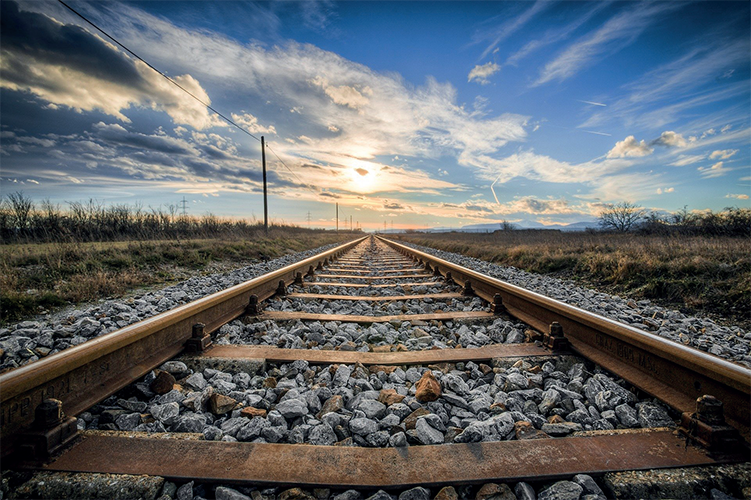
Cleaning up rail power
According to data published by the UK Government’s Department for Transport (DfT), the country’s mainline railway, which runs through the UK, produces 35.1 equivalent grams of carbon dioxide (CO2) per passenger kilometre (km).
Since the electrification process began in the mid-19th century, it has undoubtedly made our rail network greener – but there’s plenty of room for improvement. The UK
Government has pledged to remove all diesel trains from railways by 2040, and achieve a zero carbon network by 2050. To reach this goal, the rail network must strike a balance between sustainability and power quality.
Next stop, hydrogen
Supported by the DfT’s First of a Kind scheme, Riding Sunbeams, a British solar power manufacturer, aims to improve the rail network’s power supply with a solar installation that uses inverters to convert its direct current (DC) output to alternating current (AC).
With First of a Kind, the DfT is working with Innovate UK, the Government’s non-departmental innovation agency, to launch a competition with the aim of supporting innovation in rail and to accelerate its decarbonisation. The premise of Riding Sunbeams is simple. Solar farms could be installed next to the train tracks – on embankments, train sheds, nearby fields and industrial buildings – that could power the railway directly and provide traction power for the trains.
Riding Sunbeams is not alone in its renewable ambition, as rail passengers discovered for themselves when boarding Hydroflex, Britain’s first hydrogen-powered train.
Developed as a first-of-its-kind project by engineers at the University of Birmingham, UK, passengers onboard the Hydroflex train are accompanied by four hydrogen fuel tanks, alongside a fuel cell and two lithium batteries, in one of the train’s carriages.
The train is powered by a fuel cell, located in one of the train’s carriages that is made up of an anode, a cathode and an electrolyte membrane. Stored hydrogen passes through the anode, where it splits into electrons and protons. The electrons are then forced through a circuit that generates an electric charge, which can be stored in lithium batteries or sent directly to the train’s electric motor. The remainder of the hydrogen molecule then reacts with oxygen at the cathode to generate the process’s only waste part: water.
Although water emissions sound promising, the future of hydrogen-powered trains does present some lingering environmental concerns. Currently, the most common way to produce hydrogen combines natural gases with a high-temperature steam, making it a by-product of chemical processing. So, in order for hydrogen trains to become fully-sustainable in the future, the root of their fuel source must derive from renewable energy sources.
Back in motion
While research into fuel technology offers a hopeful insight into the future of sustainable rail power, until projects like the Hydroflex are rolled out widely, it’s unlikely that commuters will be sharing their commute with a lithium battery any time soon.
The Institution of Mechanical Engineers (IMechE), the London-based independent association representing mechanical engineers and engineering, reports that 42 per cent of the UK rail network is electrified, compared with as much as 76 per cent in the Netherlands. To support the efficiency of the UK’s current electrified rails, and to aid essential further investment, operators must consider the technologies that are used to manage electric energy use.
When braking, for instance, a train’s kinetic energy cannot be stored onboard. In the case of a diesel train, this energy is dissipated as heat either by using brake discs, or from a roof-mounted rheostat that regulates the current flowing through it by changing the resistance.
However, the energy produced when stopping high-speed trains is so great that disc brakes, alone, are often unsuitable because of their very high wear rates and consequent maintenance costs. Instead, a more favorable process, known as regenerative braking, allows for the immediate reuse of electricity by other locomotives.
This electricity can be transmitted through overhead wires or an electrified third rail. Alternatively, it can be stored onboard either by using a flywheel, or the regenerated electricity can be dissipated as heat by onboard or trackside resistive brakes. Because Cressall’s expanded mesh resistors are convection cooled and therefore silent, and capable of managing high powers in a compact space, they are well-suited to safely dissipating this energy.
All metro and underground trains employ regenerative braking systems to keep their passenger carriages in motion. This ability to balance the power needed to accelerate trains, with the power needed to stop them, makes metro systems one of the most energy-efficient forms of urban mass transportation.
As the use of overground rail electrification increases, regenerative braking technology could support a huge efficiency boost. However, this process works so well because of the frequency of the rail service – so, mainline trains would need to increase in number in order to truly benefit.
Hydrogen and solar power are just two of many potential technologies that could help the Government meet its green rail targets. While such developments are key to achieving a more sustainable future, considering the power technologies that already benefit our underground networks will also be vital in bringing rail technologies up-to-speed.
Simone Bruckner is managing director of power resistor manufacturer, Cressall. The world’s foremost power resistor manufacturer, Cressall Resistors, offers an unrivalled combination of experience and expertise as well as the UK’s widest range of resistor technologies. Cressall’s customers include ABB, Siemens, Areva and Alstom, as well as major utilities such as Northern Powergrid and Western Power Distribution (WPD), EDF and Scottish Power.
www.cressall.com